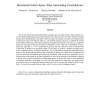Free Online Productivity Tools
i2Speak
i2Symbol
i2OCR
iTex2Img
iWeb2Print
iWeb2Shot
i2Type
iPdf2Split
iPdf2Merge
i2Bopomofo
i2Arabic
i2Style
i2Image
i2PDF
iLatex2Rtf
Sci2ools
TIT
2002
2002
Structured unitary space-time autocoding constellations
We recently showed that arbitrarily reliable communication is possible within a single coherence interval in Rayleigh flat fading as the symbol-duration of the coherence interval and the number of transmit antennas grow simultaneously. This effect, where the space-time signals act as their own channel codes, is called autocoding. For relatively short (e.g., 16-symbol) coherence intervals, a codebook of isotropically random unitary space-time signals theoretically supports transmission rates that are a significant fraction of autocapacity with an extremely low probability of error. However a constellation of the required size (typically L = 280) is impossible to generate and store, and due to lack of structure there is little hope of finding a fast decoding scheme. In this paper we propose a random, but highly structured, constellation that is completely specified by log2 L independent isotropically distributed unitary matrices. The distinguishing property of this construction is that ...
| Added | 23 Dec 2010 |
| Updated | 23 Dec 2010 |
| Type | Journal |
| Year | 2002 |
| Where | TIT |
| Authors | Thomas L. Marzetta, Babak Hassibi, Bertrand M. Hochwald |
Comments (0)

